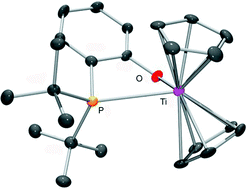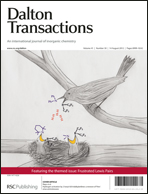Cationic Ti(iv) and neutral Ti(iii) titanocene–phosphinoaryloxide frustrated Lewis pairs: hydrogen activation and catalytic amine-borane dehydrogenation†
Abstract
Titanium–phosphorus frustrated Lewis pairs (FLPs) based on titanocene–phosphinoaryloxide complexes have been synthesised. The cationic titanium(IV) complex [Cp2TiOC6H4P(tBu)2][B(C6F5)4] 2 reacts with hydrogen to yield the reduced titanium(III) complex [Cp2TiOC6H4PH(tBu)2][B(C6F5)4] 5. The titanium(III)–phosphorus FLP [Cp2TiOC6H4P(tBu)2] 6 has been synthesised either by chemical reduction of [Cp2Ti(Cl)OC6H4P(tBu)2] 1 with [CoCp*2] or by reaction of [Cp2Ti{N(SiMe3)2}] with 2-C6H4(OH){P(tBu)2}. Both 2 and 6 catalyse the dehydrogenation of Me2HN·BH3.

- This article is part of the themed collection: Frustrated Lewis Pairs

 Please wait while we load your content...
Please wait while we load your content...